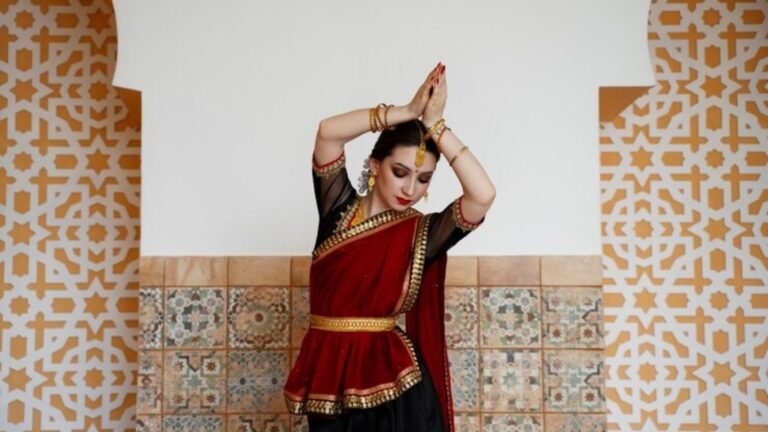India is known for its rich cultural heritage, and among its most notable contributions to the world is its classical dance forms. These dance styles are a harmonious blend of spirituality, art, and tradition. Classical Indian dance is a vital aspect of Indian culture, revered for its ancient origins, intricate movements, expressive gestures, and profound connection with mythology and religion. This article delves into the origins, characteristics, and types of classical Indian dance, while also exploring their significance in modern times.
Origins and Evolution of Classical Dance in India
Classical dance in India has a deep-rooted history dating back over 2,000 years. The origins of these dances can be traced to the Natya Shastra, a Sanskrit text attributed to the sage Bharata Muni. Written between 200 BCE and 200 CE, the Natya Shastra is a comprehensive guide on theater, dance, and music. It laid the foundation for Indian classical dance by providing the basic principles of movement, expression (known as “abhinaya”), and performance.
Indian classical dance evolved over centuries, often influenced by regional traditions, temple rituals, and royal patronage. It was an essential medium for storytelling, with dancers performing mythological narratives and spiritual themes from Hindu scriptures like the Ramayana, Mahabharata, and the Puranas. As Indian society underwent transformations due to external invasions, colonial rule, and cultural exchanges, classical dance remained a resilient symbol of India’s artistic identity.
Characteristics of Indian Classical Dance
Indian classical dance is distinguished by several defining characteristics, including:
Mudras (Hand Gestures): The use of intricate hand gestures, or “mudras,” is a fundamental aspect of Indian classical dance. Mudras serve as a language of their own, conveying emotions, actions, and stories.
Facial Expressions (Abhinaya): Dancers use facial expressions and eye movements to convey emotions like love, anger, joy, and sorrow. This art of expressing emotions is called “abhinaya,” and it adds depth and meaning to the dance.
Costumes and Makeup: Traditional costumes and elaborate makeup play a significant role in enhancing the visual appeal of Indian classical dance. Each dance form has its distinct style of clothing and ornamentation, often influenced by regional customs.
Rhythm and Music: Indian classical dance is accompanied by traditional music, often rooted in Indian ragas and talas. The rhythm, or “laya,” is a crucial element, guiding the movements and flow of the performance.
Storytelling through Dance: Most classical dances in India are narrative-driven, depicting stories from Hindu epics, folklore, and mythological texts. These stories are often spiritual in nature and aim to invoke devotion or convey moral lessons.
Major Classical Dance Forms of India
India is home to numerous classical dance forms, each with its unique style, regional origin, and cultural significance. The most prominent classical dances include:
Bharatanatyam
Origin: Tamil Nadu
Bharatanatyam is one of the oldest and most popular classical dance forms of India, originating from the temples of Tamil Nadu. Known for its precision, expressive gestures, and intricate footwork, Bharatanatyam was traditionally performed by temple dancers called Devadasis as an offering to the gods. It is characterized by its deep connection to spirituality and the portrayal of various Hindu deities through dance. Bharatanatyam often includes themes of devotion, heroism, and love, with performances based on Tamil and Sanskrit compositions.
Kathak
Origin: North India
Kathak originated in the courts of North Indian kings, evolving from the storytelling tradition of wandering bards, known as “Kathakars.” Over time, it developed into a sophisticated form of dance, incorporating elements of Persian and Mughal influence. Kathak is noted for its intricate footwork, spins (chakkars), and the rhythmic interplay between the dancer and the accompanying musicians. Unlike other Indian classical dances, Kathak does not focus solely on religious themes; it includes both spiritual and secular narratives.
Odissi
Origin: Odisha
Odissi is known for its fluid movements and sensuous grace, often resembling the temple sculptures of Odisha. Originally performed in the temples of Odisha by female dancers known as “Maharis,” Odissi is considered one of the most ancient classical dance forms. It is characterized by “tribhangi” (a posture involving three bends of the body) and intricate expressions that are deeply rooted in devotion to Lord Jagannath, a form of Vishnu.
Kathakali
Origin: Kerala
Kathakali is a dramatic and visually stunning dance form from Kerala, famous for its elaborate costumes, face paint, and larger-than-life characters. Kathakali combines dance, drama, and music to depict stories from Indian epics like the Ramayana and Mahabharata. The art form relies heavily on expressive facial movements and gestures to convey intense emotions and narratives.
Kuchipudi
Origin: Andhra Pradesh
Kuchipudi is a vibrant dance-drama tradition from Andhra Pradesh, distinguished by its lively footwork, graceful movements, and a combination of dance and dialogue. Originally, it was a male-only dance form performed by Brahmin priests, but today both men and women perform Kuchipudi. The dances often narrate stories of Hindu gods, particularly Krishna.
Manipuri
Origin: Manipur
Manipuri is a classical dance form from the northeastern state of Manipur, known for its gentle and lyrical movements. Unlike other classical dances that involve sharp, angular movements, Manipuri is characterized by its softness and fluidity. The dance often depicts themes from the Raas Leela of Lord Krishna and Radha, celebrating the divine love between them.
Mohiniyattam
Origin: Kerala
Mohiniyattam, meaning “dance of the enchantress,” is a classical dance form from Kerala performed exclusively by women. It is characterized by graceful, swaying movements and delicate gestures, typically narrating stories from Hindu mythology. The dance form has a serene and graceful quality, often associated with devotion to Lord Vishnu.
Importance of Classical Dance in Indian Culture
Classical dance in India is much more than mere entertainment; it is deeply intertwined with the country’s religious and spiritual life. For centuries, classical dances have been performed in temples, palaces, and festivals to honor the gods, celebrate cultural values, and pass down historical narratives. The following points highlight the cultural and societal importance of classical dance in India:
Spiritual Connection: Most classical dances in India have roots in religious rituals and are considered a form of worship. Performances often revolve around divine themes and are viewed as offerings to the gods.
Preservation of Tradition: Classical dance forms serve as a living tradition, preserving centuries-old art, culture, and heritage. Each performance is a reenactment of stories from the epics, keeping India’s mythological and historical narratives alive.
Cultural Identity: Classical dance is a vital aspect of Indian cultural identity. Different regions have their distinct dance styles, which reflect local customs, traditions, and religious beliefs.
Artistic Expression: Through classical dance, individuals can explore and express complex emotions, experiences, and spiritual ideas. It provides a unique medium for artists to connect with their inner selves and their audience.
The Role of Classical Dance in Modern India
In modern India, classical dance continues to thrive, although it has undergone significant transformations. Dance festivals, cultural shows, and television broadcasts have popularized these traditional forms across India and the world. Classical dancers are now adapting to contemporary themes while maintaining the essence of their art. Furthermore, many institutions are dedicated to teaching classical dance, ensuring that these ancient art forms are passed down to future generations.
Classical dance also enjoys international acclaim, with Indian dancers performing at prestigious venues worldwide. The fusion of classical dance with modern techniques has attracted younger audiences and inspired a new generation of artists to explore the boundaries of this art form.
Conclusion
Classical dance in India is a magnificent blend of art, culture, and spirituality. Each dance form reflects the rich diversity of India’s traditions, showcasing the nation’s enduring love for storytelling, devotion, and artistic expression. From Bharatanatyam in Tamil Nadu to Kathak in North India, these dances continue to captivate audiences with their beauty, complexity, and emotional depth. As a timeless representation of India’s cultural heritage, classical dance remains a significant part of the nation’s identity.
ALSO READ:Slowly Sinks As The Sun: Capturing Nature’s Tranquil Moments
FAQs
What is the oldest classical dance form in India?
Bharatanatyam, originating from Tamil Nadu, is considered one of the oldest classical dance forms in India, with roots dating back over 2,000 years.
How is Kathak different from other classical dances?
Kathak is distinct due to its emphasis on intricate footwork, spins, and a combination of both spiritual and secular themes. Unlike other classical dances, Kathak incorporates Persian and Mughal influences.
What is the significance of mudras in Indian classical dance?
Mudras are hand gestures used in classical dance to communicate specific emotions, actions, or narratives. They are an essential part of storytelling in Indian classical dance.
Can classical Indian dance be adapted to modern themes?
Yes, many classical dancers are experimenting with contemporary themes while maintaining the traditional techniques of classical dance, making the art form more accessible to modern audiences.
How are classical Indian dance forms preserved today?
Classical dance is preserved through dance schools, festivals, cultural programs, and the dedication of performers who pass on these ancient traditions to future generations.

